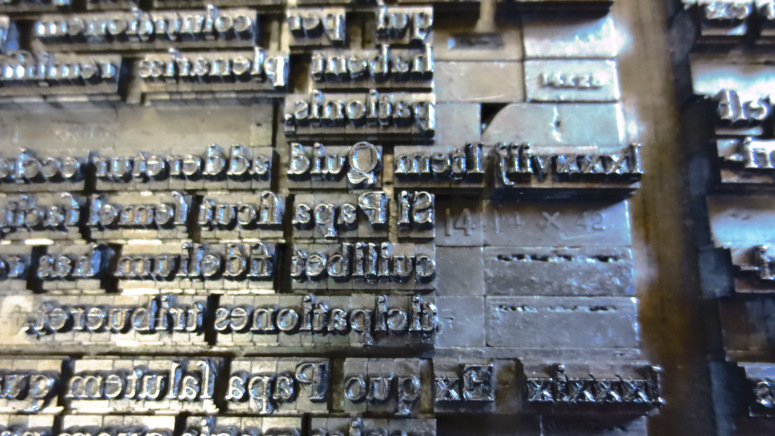
The letterpress workshop housed at the Bodleian Library has long been used for experimentation and practical teaching to academic learners at all levels. It’s now equally a site for engaging the public and schools in activities that increase their understanding of, and appreciation for, the Bodleian Libraries’ unique collections. Participatory workshops are the key method that the Bodleian Bibliographical Press uses for helping visitors to feel a connection with ‘old books’, and, through that connection, to engage with research at the University. The workshop offers public courses for adults throughout the year, and offers workshops through the library’s Education team, to schools and adult SEND learners. Planning and teaching these workshops and courses requires an understanding of how the techniques of hand-press printing can be demonstrated and also a facility for tailoring tasks to the abilities of the participants of all ages and abilities.
While teaching to academic students and teaching to the public might be regarded by some as two separate functions of the workshop, it is useful to see how academic research projects can enrich the practice of the workshop for all learners. In our experience of working with one academic project, this yielded two unexpected aspects which influenced the course that the workshop has taken over recent years. Luther’s 95 Theses, earth-shaking in terms of religious history in 1517, proved to be influential again 500 years later in our own small corner of Thomas Bodley’s ‘public library’ at Oxford. We made a re-evaluation of the type of learning that takes place, for all users of the workshop, and expanded the audiences for the workshop by connecting with special interest groups in the community around a topic of current interest.
Undertaking an exercise for Professor Henrike Laehnemann and postgraduate students from the Faculty of Medieval and Modern Languages, in printing Luther’s 95 theses as a broadside, (described in this blogpost by Charlotte Hartmann), we were challenged to extend the ambitions of the press technically. The length of Luther’s text nearly exhausted the Bodleian’s relatively generous supply of type, and in the end the single side of the broadside was printed in two parts, which needed to be printed to very exacting standards to appear in four parallel columns.
A challenge was posed by the 16th-century printer’s expedients to make Luther’s words fit into the original pamphlet length; having carefully divided the text from the pamphlet version into two halves, it became clear that the second half of the pamphlet contained more abbreviations. The 16th-century printer of the pamphlet had been trying to save space as he approached the end of the setting, to make it fit within 8 pages on a single sheet of paper. The print run of the Bodleian’s broadside version was much longer than usually attempted for any publications at the workshop – 200 – making 400 passes of the sheets through the press, as two halves of the text were set and printed in sequence.
Richard Lawrence is an Oxford printer with his own workshop, who teaches printing at the Bodleian to students and the public. He oversaw the type-setting and printing of the Luther Theses broadside, and comments,
The Luther Theses broadside is the largest text printed on the Bodleian’s hand-operated presses, and having copies of this broadside in the workshop has set an important standard for the kind of work that can be undertaken, and a model for collective contribution to a larger project.
We learned from this that a technical challenge is a key factor in encouraging learning. This project required a large amount of type-setting by untrained type-setters. Contrary to an idea that the role of a class might be to deliver the theory of type-setting in a lecture, and participants might learn from just a small amount of practice, the Luther Theses project showed that only added practice enabled participants to use their new skills more fully, to recognize and correct errors, and to become competent and creative. For learners with the stamina and ability to undertake a lot of type-setting, this is a key factor in their development, and is now something we look out for and encourage in the public classes.
The 2017 Luther anniversary, focussed around Luther’s use of the printing press to get his message across, also encouraged us to get the presses moving out of the workshop on several occasions; for a re-enactment of Luther’s famous fixing of the theses to the door of the church in Wittenberg; a ‘Print your own Theses’ open event at the workshop in May 2017; for the book launch of a Reformation pamphlet reprint by the Taylorian Library (Oxford’s library for Modern Languages); and by lending presses to St Edmund’s Hall, one of Oxford’s colleges, for a Research Day open to the public. This approach, seeing the presses as mobile, has encouraged further use of the presses in the public areas of the Bodleian’s Weston Library, and a small press has been refitted with a mobile stand to enable its use at different venues. The Reformation projects as a whole drew new audiences to the printing press – English and German community members celebrating the 70th anniversary of the Bonn-Oxford town twinning, and postal requests for copies of the 95 theses after images had been posted on social media.

2 thoughts on “From research to craft: printing Luther’s theses and teaching letterpress”